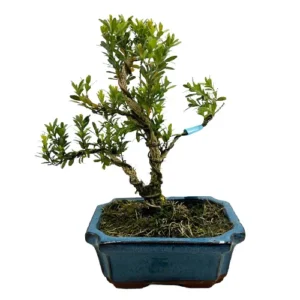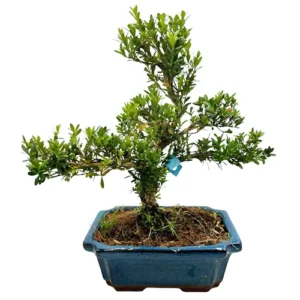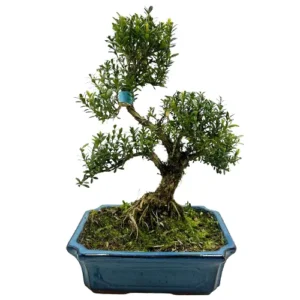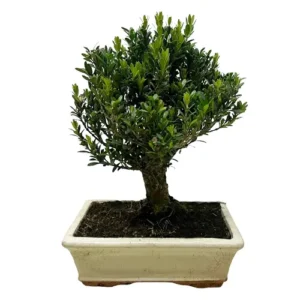The Chinese Box bonsai tree (buxus harlandii) is evergreen with small leaves and bark that looks aged. Chinese Box trees are a popular choice for beginners
Chinese Box Tree (buxus harlandii)
Chinese box bonsai tree (buxus harlandii), also called Japanese box tree is an evergreen shrub that is native to China. It is normally used for hedging but makes a suitable bonsai for its tiny green leaves, and trunk with bark that makes the tree appear much more aged than it is.
Placement
The Chinese Box bonsai Tree is quite a hardy species. Choose an outdoor location that is sunny, but it will do well somewhere semi-shaded too.
During the winter, even though in nature they are generally frost-resistant, when planted in a small pot for bonsai, the roots of your box tree are at risk of freezing. We recommend protecting your it from frost and strong winds, and consider using a cold frame or bringing it indoors to an unheated space such as a greenhouse against the worst of the weather.
Watering
There is no definitive guide to watering and it should be conducted on an observational schedule, not a routine. This means that it is important to keep an eye on the moisture levels of the soil to avoid over and under watering, both which can lead to dropping leaves and/or root death. The amount of water a bonsai requires depends on pot size, climate, airflow, soil and tree type so it is best to use your eyes and fingers to assess whether the soil is damp, wet or dry.
If the top inch or so of soil has dried, it is ready to be watered. When you water, ensure an even coverage over the roots and soil, allowing water to flow out from the bottom of the pot to ensure a good soaking. If you are a first-time bonsai owner, another good way to water is by submerging the entire pot in water until the bubbles stop. If you choose this method, be aware that your chinese box bonsai tree may not need watering for another two or three days, but this will depend on the factors mentioned above.
Fertilising
Using fertiliser on your Chinese Box bonsai Tree will help encourage healthy growth and this should be done periodically from once a week to every two months and only during the growing season. You can start adding Chrystal Liquid Bonsai Feed to your water from March until October and use weekly. Use Naruko Fertiliser Slow Release Bonsai Feed once every one to two months. With bonsai trees, less is more, and we tend to advise using half the recommended dosage to see how your bonsai reacts first.
Pruning and wiring
Pruning your bonsai is important not only to maintain or create an aesthetic style but to also ensure light and airflow can reach inner leaves and the Box Tree tolerates constant pruning very well. During the early to late spring months use appropriate tools to cut back stems which have grown longer than four leaves, leaving the two leaves which are closest to the stem intact. You can repeat this process when new stems appear after pruning. It is easy to create ramification with the box tree simply by regular pruning in late spring. To refine the foliage, pinch out new growth for the rest of the year. The boxwood can grow very thick and bushy so ensure to thin out the inner leaves and branches in order to let light and air through.
Training your bonsai using wiring is best done while the branches are still soft and young. Even though the more mature branches appear as very hard-looking wood, the bark is very delicate and prone to scarring for a long time. Once your Chinese Box bonsai Tree is older, it is sufficient to shape it by pruning alone.
Repotting
Repotting your tree is an important way to provide a fresh and suitable soil mix and ensure appropriate root health. Repot in early spring. Generally, your Chinese box bonsai tree will need to be re-potted once every two years if it is young, while older ones can stay in their pots for longer. However, you should always check if it has become root-bound before you change pots. You can do this by lifting the tree gently out of the pot by the main trunk and examining the root system. You will know it is ready if you can see that the roots are circling around each other and the pot. If, however, they still appear contained in the soil, you should place it back and wait until the following spring to check again. Note that re-potting the tree too early could result in it growing vigorously, producing undesirable bonsai traits such as larger leaves.
Choose a pot that is slightly bigger, reflects the tree’s style, leaf and bark colour and is a suitable material.
The roots of a Chinese box bonsai tree can be pruned considerably. It is important that the soil mix you choose for the new pot is well-draining and we tend to use a mixture of different speciality bonsai soils on our trees. Every species is different so please contact us for free soil-mix advice or to take advantage of our re-potting service, visit www.miyagibonsai.co.uk/services/.
For further information and advice on your bonsai tree, please refer to our blog at ………..
For tools, fertilisers, soils, pots and other accessories please visit…….
Showing all 4 results




